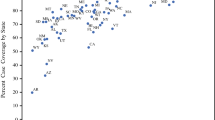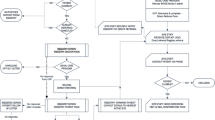Abstract
Melanoma is often managed outside hospital settings, creating the potential for underreporting to cancer registries. To our knowledge, completeness of melanoma capture in cancer registries has not been assessed using external data sources since the 1980s. We evaluated the melanoma capture rate from 1993 to 2009 in a provincial cancer registry. We identified all melanoma diagnoses in pathology reports from a major community laboratory in Ontario, Canada. Pathologically confirmed diagnoses were linked to Ontario Cancer Registry (OCR) records using health insurance numbers. We calculated capture rates as the proportion of patients with melanoma confirmed by a pathology report, with a corresponding melanoma diagnosis in OCR. OCR captured 3,798 of 4,275 (88.8, 95 % confidence interval: 87.9, 89.8 %) invasive melanoma diagnoses over the 17-year period. Annual capture rates of 94 % or higher were found for over half the study period. Among all 29,133 melanoma diagnoses in OCR, 27.6 % were registered based on a pathology report alone, compared with 3.4 % for non-cutaneous malignancies. This suggests that comprehensive capture of melanoma cases by a provincial cancer registry is achievable using source data from community laboratories. There is a need for ongoing validation to ensure data remain accurate and complete to reliably inform clinical care, research, and policy.

Similar content being viewed by others
Abbreviations
- ICD:
-
International Classification of Diseases for Oncology
- OCR:
-
Ontario Cancer Registry
References
Canadian Cancer Society’s Advisory Committee on Cancer Statistics (2014) Canadian cancer statistics 2014. Canadian Cancer Society, Toronto
American Cancer Society (2014) Cancer facts and figures 2014. American Cancer Society, Atlanta
Cancer Research UK (2013) Cancer statistics report—skin cancer. Cancer Research UK, London
Ferlay J, Steliarova-Foucher E, Lortet-Tieulent J, Rosso S, Coebergh JW, Comber H, Forman D, Bray F (2013) Cancer incidence and mortality patterns in Europe: estimates for 40 countries in 2012. Eur J Cancer 49(6):1374–1403. doi:10.1016/j.ejca.2012.12.027
Cancer Care Ontario. The Ontario Cancer Registry. https://www.cancercare.on.ca/ocs/csurv/stats/ocr/. Updated 11 Jan 2012. Accessed 20 March 2014
Cockburn M, Swetter SM, Peng D, Keegan TH, Deapen D, Clarke CA (2008) Melanoma underreporting: Why does it happen, how big is the problem, and how do we fix it? J Am Acad Dermatol 59:1081–1085. doi:10.1016/j.jaad.2008.08.007
Cartee TV, Kini SP, Chen SC (2011) Melanoma reporting to central cancer registries by US dermatologists: an analysis of the persistent knowledge and practice gap. J Am Acad Dermatol 65(5 Suppl 1):S124–S132. doi:10.1016/j.jaad.2011.05.032
Hall HI, Jamison P, Fulton JP, Clutter G, Roffers S, Parrish P (2002) Reporting cutaneous melanoma to cancer registries in the United States. J Am Acad Dermatol 49(4):624–630
Paterson IC, Beer H, Jones DA (2001) Under-registration of melanoma in Wales in 1998: use of the capture–recapture method to estimate the ‘true’ incidence. Melanoma Res 11:141–145
Melia J, Frost T, Graham-Brown R et al (1995) Problems with registration of cutaneous malignant melanoma in England. Br J Cancer 72:224–228
Koh HK, Clapp RW, Barnett JM et al (1991) Systemic underreporting of cutaneous malignant melanoma in Massachusetts. Possible implications for national incidence figures. J Am Acad Dermatol 24(4):545–550
Karagas MR, Thomas DB, Roth GJ, Johnson LK, Weiss NS (1991) The effects of changes in health care delivery on the reported incidence of cutaneous melanoma in western Washington state. Am J Epidemiol 133(1):58–62
Reynolds DL, Nguyen VC, Clarke EA (1991) Reliability of cancer mortality statistics in Ontario: a comparison of incident and death diagnoses, 1979–1983. Can J Public Health 82(2):120–126
McLaughlin JR, Kreiger N, Marrett LD, Holowaty EJ (1991) Cancer incidence registration and trends in Ontario. Eur J Cancer 27(111):1520–1524
Merlino LA, Sullivan KJ, Whitaker DC, Lynch CF (1997) The independent pathology laboratory as a reporting source for cutaneous melanoma incidence in Iowa, 1977–1994. J Am Acad Dermatol 3(4):578–585
Robles SC, Marrett LD, Clarke EA, Risch HA (1988) An application of capture–recapture methods to the estimation of completeness of cancer registration. J Clin Epidemiol 41(5):495–501
Walter SD, Bimie SE, Marrett LD, Taylor SM, Reynolds D, Davies J, Drake JJ, Hayes M (1994) The geographic variation of cancer incidence in Ontario. Am J Public Health 84(3):367–376
Tilling K (2001) Capture–recapture methods—useful or misleading? Int J Epidemiol 30(1):12–14
Wang M, Hatcher J, Cancer Projection Analytical Network Working Team (2010) Data quality assessment report for canadian cancer surveillance. Cancer projections network (C-Projections), Alberta Health Services. http://www.cancerview.ca/idc/groups/public/documents/webcontent/csen_cproj_data_q_as_report_q4.pdf
Clarke EA, Marrett LD, Kreiger N (1991) Cancer registration in Ontario: a computer approach. IARC, Lyon (IARC Scientific Publications, no. 95)
Youlden DR, Youl PH, Soyer H, Aitken JF, Baade PD (2014) Distribution of subsequent primary invasive melanomas following a first primary invasive or in situ melanoma in Queensland, Australia, 1982–2010. JAMA Dermatol 150(5):526–534
van der Leest RJ, Liu L, Coebergh JW, Neumann HA, Mooi WJ, Nijsten T, de Vries E (2012) Risk of second primary in situ and invasive melanoma in a Dutch population-based cohort: 1989–2008. Br J Dermatol 167:1321–1330. doi:10.1111/j.1365-2133.2012.11123.x
Balamurugan A, Rees JR, Kosary C, Rim SH, Li J, Stewart SL (2011) Subsequent primary cancers among men and women with in situ and invasive melanoma of the skin. J Am Acad Dermatol 65(5 Suppl 1):S69–S77. doi:10.1016/j.jaad.2011.04.033
Spanogle JP, Clarke CA, Aroner S, Swetter SM (2010) Risk of second primary malignancies following cutaneous melanoma diagnosis: a population-based study. J Am Acad Dermatol 62(5):757–767. doi:10.1016/j.jaad.2009.07.039
Haenssle HA, Korpas B, Hansen-Hagge C, Buhl T, Kaune KM, Johnsen S, Rosenberger A, Schon MP, Emmert S (2010) Selection of patients for long-term surveillance with digital dermoscopy by assessment of melanoma risk factors. Arch Dermatol 146(3):257–264. doi:10.1001/archdermatol.2009.370
Rhodes AR, Weinstock MA, Fitzpatrick TB, Mihm MC Jr, Sober AJ (1987) Risk factors for cutaneous melanoma: a practical method of recognizing predisposed individuals. JAMA 258(21):3146–3154
van der Leest RJ, Flohil SC, Arends LR, de Vries E, Nijsten T (2014) Risk of subsequent cutaneous malignancy in patients with prior melanoma: a systemic review and meta-analysis. J Eur Acad Dermatol Venereol. doi:10.1111/jdv.12887
Acknowledgments
This work was supported by a Canadian Institutes of Health Research team Grant (OTG-88591); and a Canadian Dermatology Foundation research Grant.
Author information
Authors and Affiliations
Corresponding author
Ethics declarations
Conflicts of interest
None.
Rights and permissions
About this article
Cite this article
Tran, J.M., Schwartz, R., Fung, K. et al. Comprehensive capture of cutaneous melanoma by the Ontario Cancer Registry: validation study using community pathology reports. Cancer Causes Control 27, 137–142 (2016). https://doi.org/10.1007/s10552-015-0690-5
Received:
Accepted:
Published:
Issue Date:
DOI: https://doi.org/10.1007/s10552-015-0690-5




